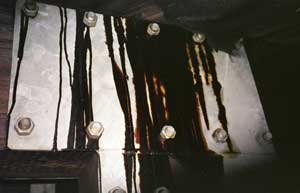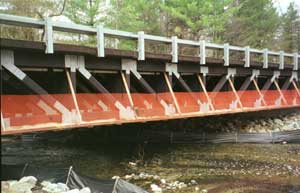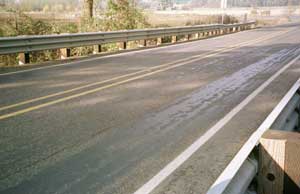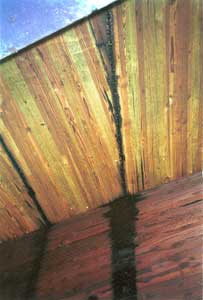 Privacy
| Legal Privacy
| Legal |
Table
of Contents Back | Next | Home | Cover Page |
Technology & Development Center |
Asphalt Paving of Treated Timber Decks
An asphalt paving system on a bridge deck may include a geotextile or paving membrane, a tack coat, and one or more layers of asphalt pavement. Improper pavement system design, incompatible products, poor construction practices, or climatic conditions may cause a pavement system to fail on treated timber bridge decks. Asphalt pavement materials must be at the proper temperature when they are placed and compacted. Cold air can affect placement and cause faster curing of the asphalt and lead to cracking and improper bonding between the asphalt, aggregate, and the deck surface. The most common problem seen in field inspections was excess amounts of asphalt and preservative. Another common problem was that paving membranes became unstable and slipped when the hot asphalt pavement was being placed.
A tack coat is a very light application of asphalt, usually an asphalt emulsion diluted one to one with water, applied to ensure a bond between the surface being paved and the overlying asphalt pavement course. A tack coat should be quite thin, just thick enough to help the dry fabric or asphalt overlay stick to the underlying surface. The application rate for a tack coat varies for different applications. A concrete bridge deck needs a heavier application because the relatively porous concrete surface will absorb the asphalt. A timber bridge deck treated with creosote, penta, or copper naphthenate carried in a heavy oil solvent already has an oily surface. The asphalt emulsion will not penetrate the timbers well. A diluted application rate of 0.25 gallons of asphalt per square yard may be appropriate for a concrete bridge deck. An application rate of 0.05 to 0.10 gallons of asphalt per square yard is more appropriate for a treated timber bridge deck. The rate depends on how quickly the asphalt is absorbed by the material below and above it. During an installation, too much liquid asphalt acts more like a lubricant than a bonding agent and causes pavements, fabrics, or membranes to slip and bunch. Any excess asphalt placed against the treated wood will cause long-term problems.
Concern about water penetration causing wood to deteriorate and dissolved roadway salts causing steel components to rust has prompted the widespread use of rubberized asphalt paving membranes in many asphalt paving systems on treated timber bridges. Waterproofing requires a continuous layer of asphalt. Rubberized asphalt works even better than standard asphalt, because it is less likely to crack during cold weather. Paving membranes are paving fabrics or fiber mesh impregnated with polymer-modified or rubberized asphalt. While paving membranes were originally produced to prevent problems, their indiscriminate use on treated timber bridge decks has caused installation, durability, and environmental problems.
One side of some paving membranes is sticky and designed to adhere to the bridge surface. Other paving membranes are designed to adhere to a tack coat or primer. These membranes were developed for concrete bridge decks where the hot asphalt overlay melts the membrane, fills surface voids in the concrete, and tightly bonds the asphalt overlay to the bridge deck. Often, a primer or sealer is recommended for the concrete surface to decrease the porosity of the concrete and improve the bond. This continuous layer of asphalt produces a waterproof seal of the concrete bridge deck. Waterproofing concrete decks is important because reinforcing steel can be damaged by water and dissolved roadway salts. In most cases, properly treated timber decks are not nearly as susceptible to damage by moisture and salt.
Treated timber bridge decks present a different installation challenge than concrete decks. Timber decks treated with oilborne preservatives will not absorb the melted paving membrane. Timber decks do not absorb and dissipate the heat of the asphalt overlay as readily as concrete. When 280 to 300 °F asphalt is placed on an asphalt-impregnated paving membrane on a treated timber deck, the membrane immediately melts, forming a pool of liquid asphalt between the deck and the asphalt pavement. As the fabric slips under the asphalt pavement, it may fold and bunch in front of the paving machine. Various attempts have been made to prevent the fabric from folding and bunching, including stapling the membrane to the timber deck, and filling the paving machine's hopper before paving so the paving machine will not have to push a truck in front of it.
Example 10—The LaChance Bridge, constructed in 1998 near Cadillac, MI, was part of the State's creosote retention study. It has creosote-treated, glued-laminated transverse deck panels across timber deck trusses. The average creosote retention in the deck panels was 35.7 pounds per cubic foot. An asphalt-impregnated paving membrane was installed before paving. Construction personnel related difficulties in paving because the membrane slipped. The paving was done on a cool November day. Immediately after paving, long strands of cooled asphalt were visible (figure 20a) at the deck panel joints on the underside of the bridge.
The bridge began dripping a mixture of creosote and asphalt into the Clam River the following spring. A collection system was installed under the bridge (figure 20b). The creosote and rubberized asphalt mixture was still dripping when the bridge was inspected in 2000.

Figure 20a—Cooled asphalt dripping from the
underside of the LaChance Bridge in Michigan.
.
Figure 20b—A collection system catches the
creosote and rubberized asphalt dripping
from the underside of the bridge.
Even if a bridge is successfully paved and the deck is tight enough to prevent melted membrane asphalt from dripping between the deck panels, the layer of asphalt remains at the wood-pavement interface. When combined with preservative residue, this concentration of asphalt will soften asphalt pavement and cause ongoing problems, such as bleeding, overlay deterioration, and rutting, particularly when bleeding treatment chemicals and solvents add additional solvents and oils to the mix.
Rubberized asphalt from the paving membranes does not leak just because it is being melted by the hot asphalt pavement. The LaChance Bridge was still dripping between the deck panels 2 years after installation.
Washington County, OR, workers replaced the decks on a number of treated timber bridges in the summer of 1998 and on four others in 2000. On two of the bridges, the alternating longitudinal deck panels had been treated with either penta or copper naphthenate (figure 21). This approach allowed the performance of glued laminates treated with copper naphthenate to be evaluated. At the time, copper naphthenate was a relatively new treatment for bridges. The third bridge deck was treated entirely with penta. The fourth bridge deck was treated with ammoniacal copper/zinc arsenate (ACZA), a waterborne treatment. The solvent for all the decks treated with oilborne preservatives was type A heavy oil. Rubberized asphalt-impregnated paving membranes were used on all four bridge decks.

Figure 21—Alternating longitudinal deck panels treated
with penta and copper naphthenate on a bridge
in Washington County, OR.
All three decks treated with oilborne preservatives showed significant dripping of the rubberized asphalt from the paving membranes. The pavement surfaces of these three bridges were rutted and showed signs of asphalt bleeding. One bridge deck had two large potholes near the center of the bridge. The deck panels treated with penta exhibited more asphalt bleeding than the deck panels treated with copper naphthenate. The extra bleeding may have occurred because the penta panels were in the wheel paths.
The bridge deck treated with waterborne preservatives showed almost no asphalt dripping, and the pavement surface had no obvious signs of asphalt bleeding.
Two Forest Service bridges also exhibited long-term membrane dripping. The deck of the Rogue River Bridge was replaced in 1998. The deck panels were treated with penta in a type A heavy oil solvent. A paving membrane was installed over a bridge deck against a primer and tack coat.
Some difficulty was experienced with membrane slippage. No membrane dripping problems were immediately apparent. Two years later, dissolved rubberized asphalt began dripping from between the deck panels (figure 22). The problem was severe enough that plywood was nailed to the bottom of the joints to collect the dripping asphalt.

Figure 22—Rubberized asphalt dripping from
paving membranes on the Rogue River
Bridge near Medford, OR.